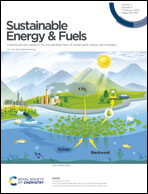Favoring the generation and utilization of photocatalytic reactive species over g-C3N4 nanosheets by controllable edge C modification†
Abstract
Defect engineering is an effective strategy to broaden the light-harvesting range and increase the separation efficiency of photogenerated charge carriers in semiconductor photocatalysts. The photocatalytic activity of g-C3N4 is expected to be improved by introducing the conductive C species. Here, we developed a facile approach to prepare C-modified g-C3N4 by the co-polymerization of melamine and a long-chain hydrocarbon, cetyltrimethylammonium chloride. The light-harvesting capacity was significantly enhanced by the successful introduction of C-containing groups on the edge with preserving the tri-s-triazine framework structure. The enhanced light absorption ability can provide a prerequisite for effective charge generation. The production amounts of electrons, hydroxyl, and superoxide radicals increased according to the electron paramagnetic resonance measurements. Photocurrent and photoluminescence measurements demonstrated that the recombination of charge carriers was effectively restrained; thus, the reactive species can be separated and transferred, and then they can participate in redox reactions efficiently. The improved H2 generation rate and methylene blue degradation efficiency manifested that the generation and utilization efficiency of photoexcited reactive species were effectively promoted. The edge C species modification on the tri-s-triazine framework by long-chain alkanes in our work provides an alternative way to improve the generation ability of the reactive species, which is helpful in enhancing the utilization efficiency of solar energy.



 Please wait while we load your content...
Please wait while we load your content...